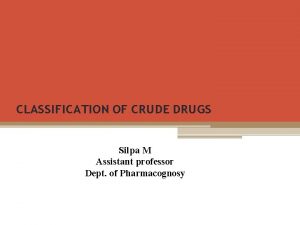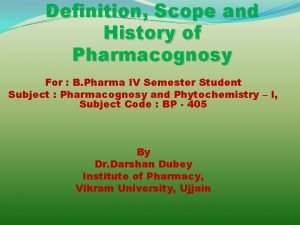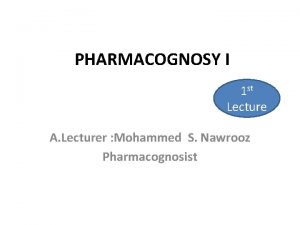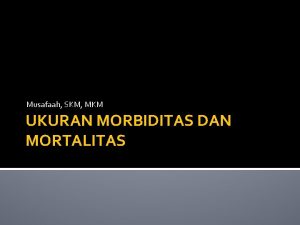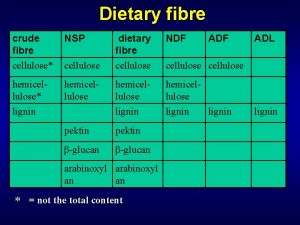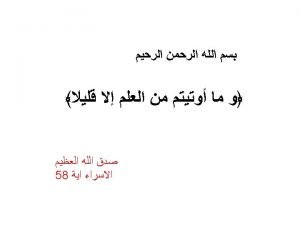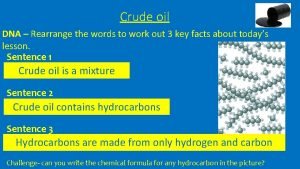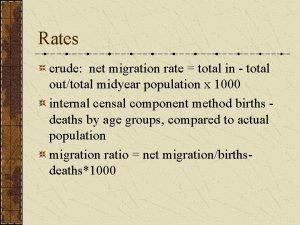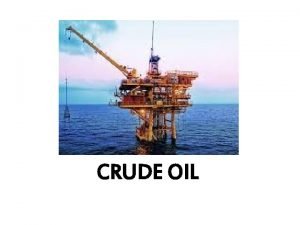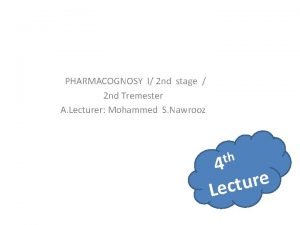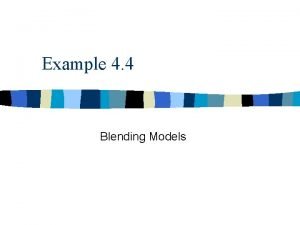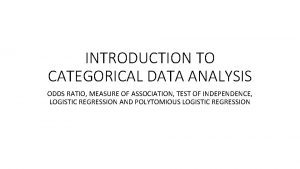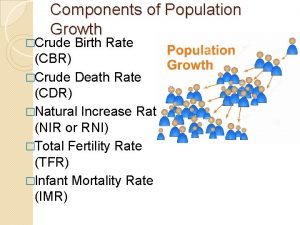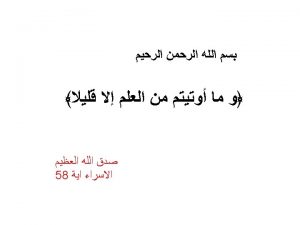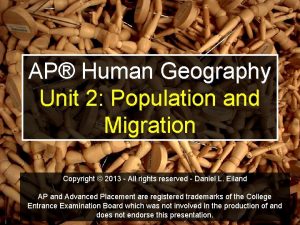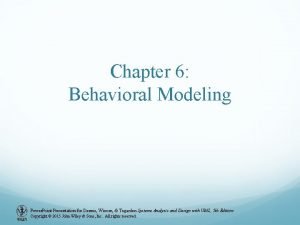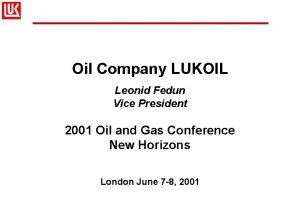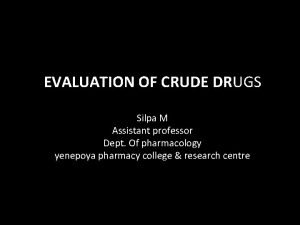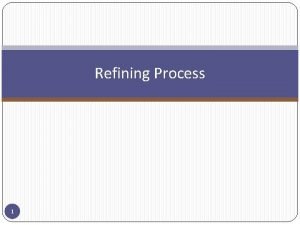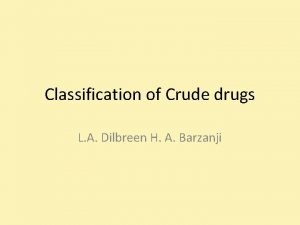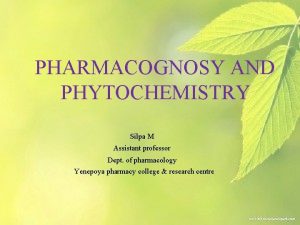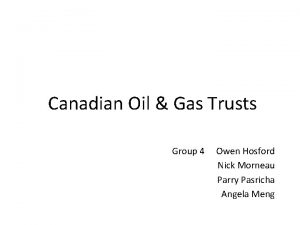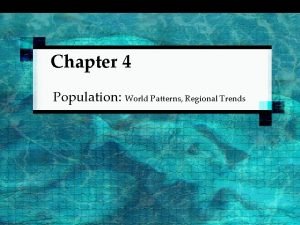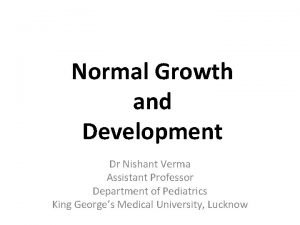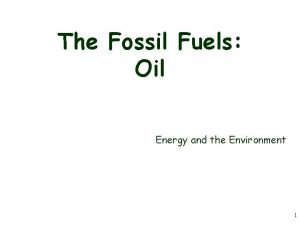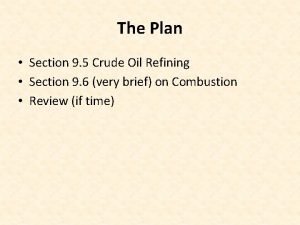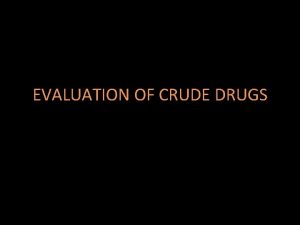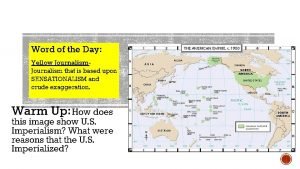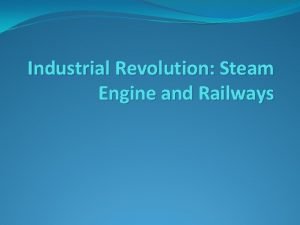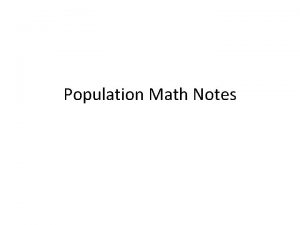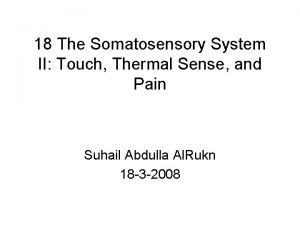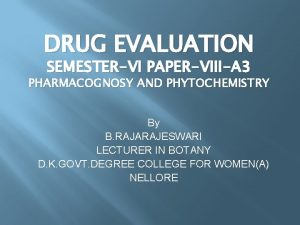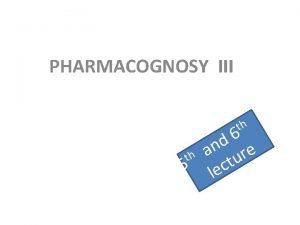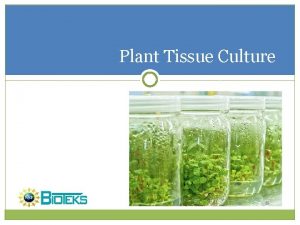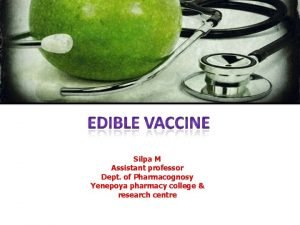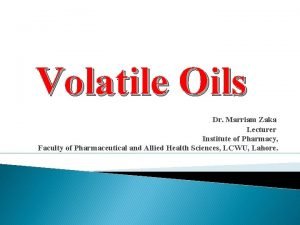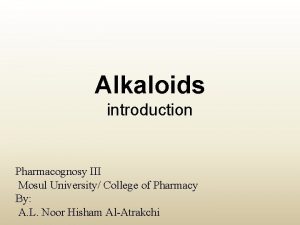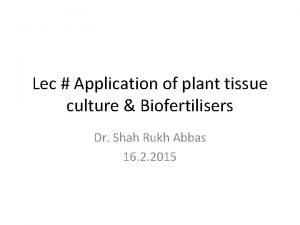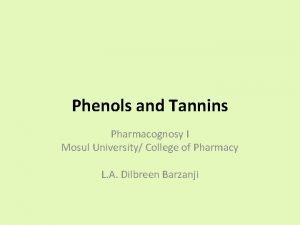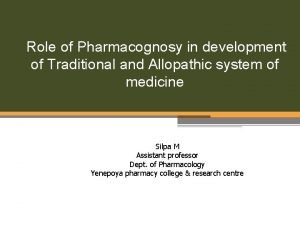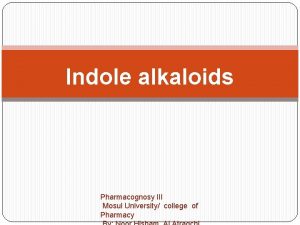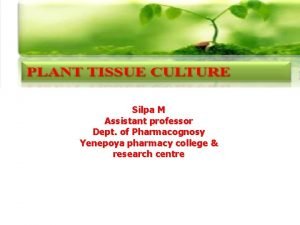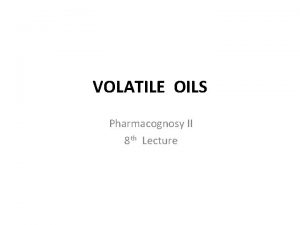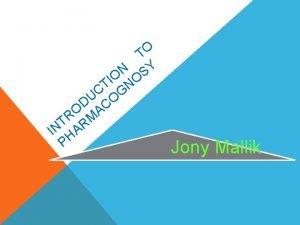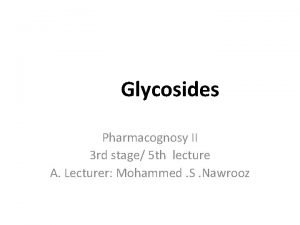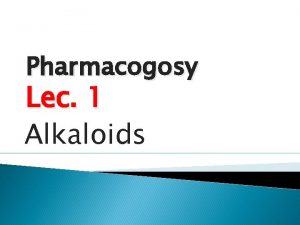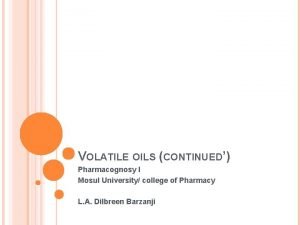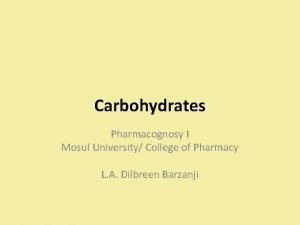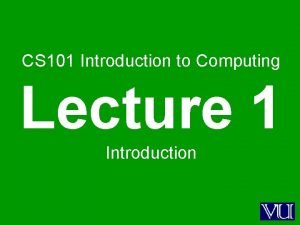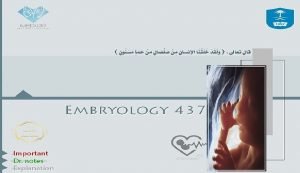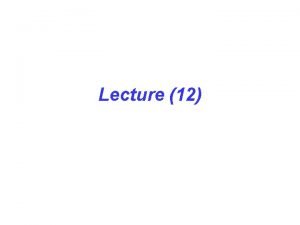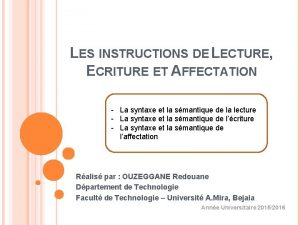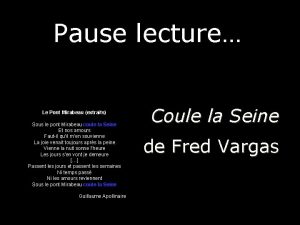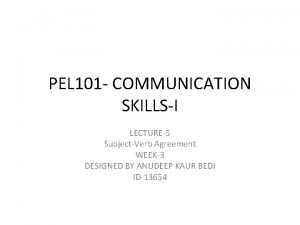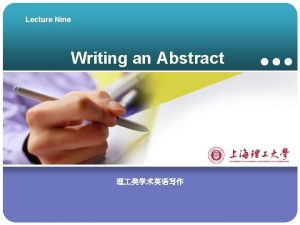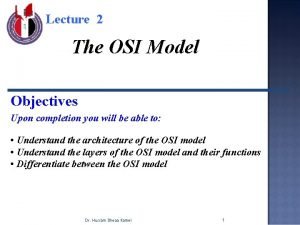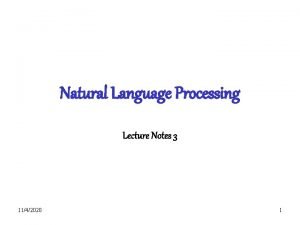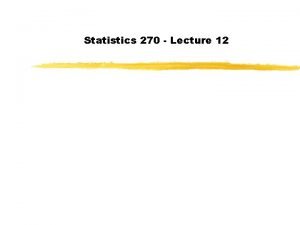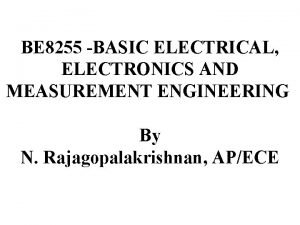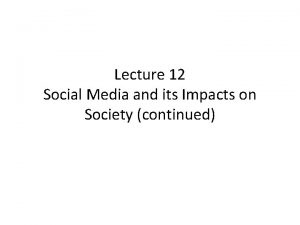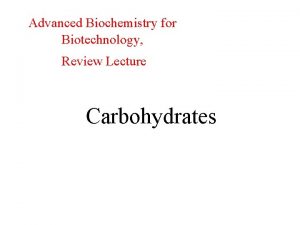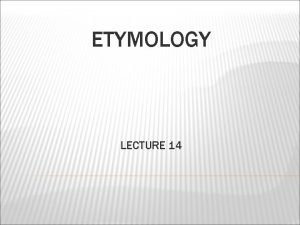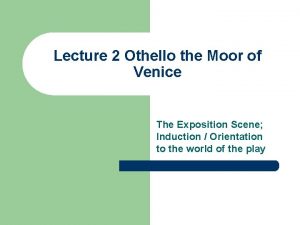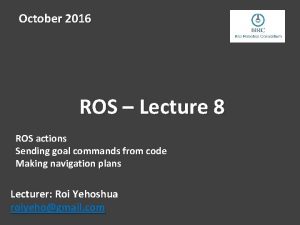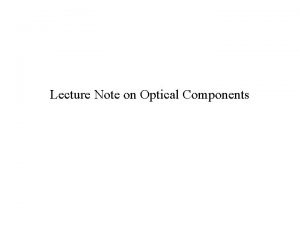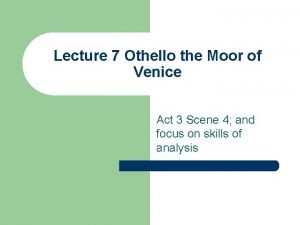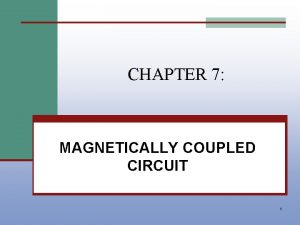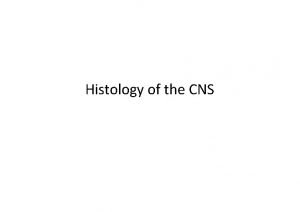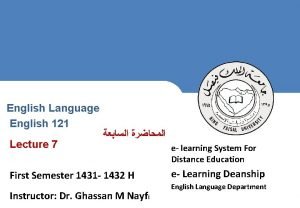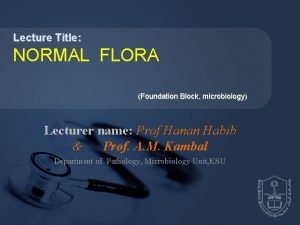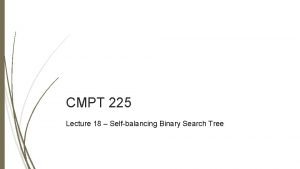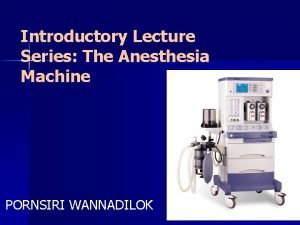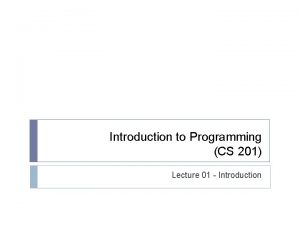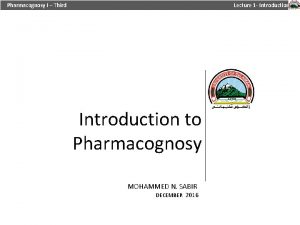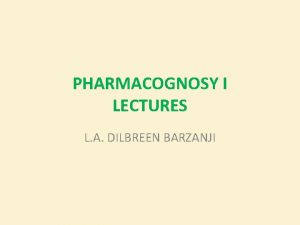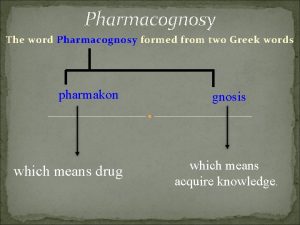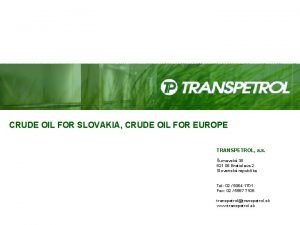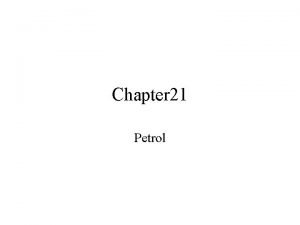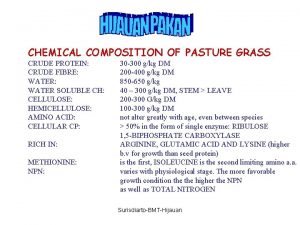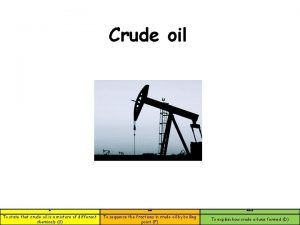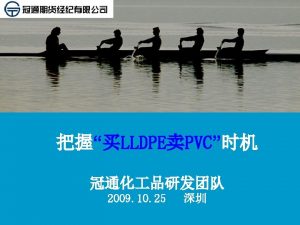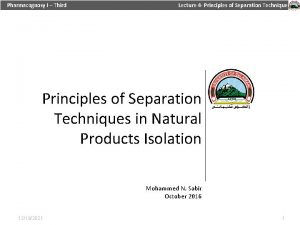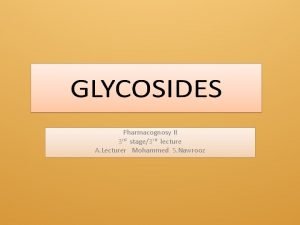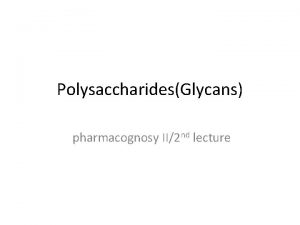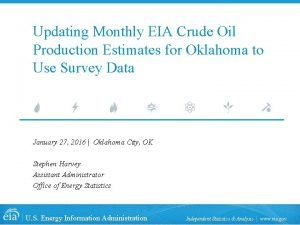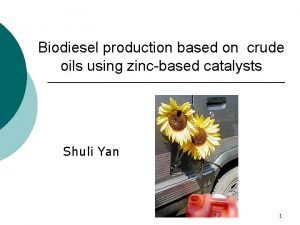Pharmacognosy I Third Lecture 2 Production of crude


























































































































- Slides: 122

Pharmacognosy I – Third Lecture 2 - Production of crude drugs Production of Crude Drugs and Q. C of NPs MOHAMMED N. SABIR DEC. 2016

Pharmacognosy I – Third Lecture 2 - Production of crude drugs Lecture overview • Review of the last lecture • Introduction • Production of crude drugs 12/21/2021 2

Pharmacognosy I – Third Lecture 2 - Production of crude drugs Obtaining a template or lead compound from nature Drug Discovery Cycle Primary Assays High Through-P in vitro Obtaining a template or lead compound by chemical synthesis Drug Design 12/21/2021 Secondary Assays Counter screens, bioavailability Toxicity, metabolism, etc. Indirect Direct Lead Compound and SAR Structural characterization of Protein-Ligand Complex Clinical Candidate 3

Pharmacognosy I – Third Lecture 2 - Production of crude drugs The crude drug which reaches the pharmaceutical manufacturing line will have passed through various stages, all of which influence the nature (quality) and amount (quantity) of active constituents present. 12/21/2021 4

Pharmacognosy I – Third Lecture 2 - Production of crude drugs These aspects will be considered under the headings: q q q q Environmental conditions. Cultivated and wild plants. Collection Drying. Storage. European regulations. Quality control 12/21/2021 5

Pharmacognosy I – Third Lecture 2 - Production of crude drugs Environmental conditions Plant growth and development, the nature and quantity of secondary metabolites, are affected by: 1. Temperature. 2. Rainfall. 3. Day length (Including the quality of light). 4. Altitude. 12/21/2021 6

Pharmacognosy I – Third Lecture 2 - Production of crude drugs 1 - Temperature In general, the formation of volatile oils appears to be enhanced at higher temperatures, although very hot days may lead to an excess physical loss of oil. 12/21/2021 7

Pharmacognosy I – Third Lecture 2 - Production of crude drugs 1 - Temperature While fixed oil produced at low temperatures contains fatty acids with a higher numbers of unsaturation than those formed at higher temperatures. 12/21/2021 8

Pharmacognosy I – Third Lecture 2 - Production of crude drugs 1 - Temperature 12/21/2021 9

Pharmacognosy I – Third Lecture 2 - Production of crude drugs 1 - Temperature The mean optimum temperature for (-)-nicotine production in Nicotiana rustica is 20 OC. 12/21/2021 10

Pharmacognosy I – Third Lecture 2 - Production of crude drugs 2 - Rainfall Considered in relation to the annual rainfall, its distribution throughout the year, its effect on humidity and its effect coupled with the water-holding properties of the soil. 12/21/2021 11

Pharmacognosy I – Third Lecture 2 - Production of crude drugs 2 - Rainfall Continuous rain can lead to loss of water-soluble substances from leaves and roots by leaching; such situation is seen in plants containing quaternary alkaloids, glycosides and even volatile oils. 12/21/2021 12

Pharmacognosy I – Third Lecture 2 - Production of crude drugs 2 - Rainfall 12/21/2021 13

Pharmacognosy I – Third Lecture 2 - Production of crude drugs 2 - Rainfall This could account for low yields of some active constituents in wet seasons from plants whose general condition appears to be good. 12/21/2021 14

Pharmacognosy I – Third Lecture 2 - Production of crude drugs 2 - Rainfall In Cassia angustifolia it has been shown that short-term drought increase the concentration of Sennosides A + B but in the longer term causes loss of leaf biomass. http: //www. 101 herbs. com/cassia-angustifolia. html 12/21/2021 15

Pharmacognosy I – Third Lecture 2 - Production of crude drugs 3 - Day length Including the quality of light Plants varies in both the amount and intensity of the light which they require. 12/21/2021 16

Pharmacognosy I – Third Lecture 2 - Production of crude drugs 3 - Day length In the wild state the plant will be found where its shade requirements are met, and under cultivation similar shade must be provided. 12/21/2021 17

Pharmacognosy I – Third Lecture 2 - Production of crude drugs 3 - Day length Light is a factor which helps to determine the amount of glycosides or alkaloids produced. 12/21/2021 18

Pharmacognosy I – Third Lecture 2 - Production of crude drugs 3 - Day length With Atropa belladonna and Cinchona ledgeriana full sunshine gives higher content of alkaloids than does shade. 12/21/2021 19

Pharmacognosy I – Third Lecture 2 - Production of crude drugs 3 - Day length Dimerization of the indole alkaloids Catharanthine and Vindoline leading to Vinblastine is aided by UV light. 12/21/2021 20

Pharmacognosy I – Third Lecture 2 - Production of crude drugs 3 - Day length N 12/21/2021 21

Pharmacognosy I – Third Lecture 2 - Production of crude drugs 3 - Day length Such dimerization is demonstrated when irradiation of intact plants with near UV-light in the range 290 -380 nm stimulates the synthesis of dimeric alkaloids, probably by inducing catharanthine oxidation as a trigger reaction. 12/21/2021 22

Pharmacognosy I – Third Lecture 2 - Production of crude drugs 3 - Day length The daily variation in the proportion of secondary metabolites is probably light-controlled. The type of radiation which plants receive is also important. 12/21/2021 23

Pharmacognosy I – Third Lecture 2 - Production of crude drugs 4 - Altitude Some plants like (Tea, Cocoa, Coffee, medicinal Rhubarb, Tragacanth, Erythroxyllum and Cinchona requires elevation. 12/21/2021 24

Pharmacognosy I – Third Lecture 2 - Production of crude drugs 4 - Altitude In reverse the coconut of palm needs a lowland area. In case of Cinchona succirubra, although the plant growth is well at lower altitudes, but it produce no alkaloids. http: //cagayandeorojournal. blogspot. com/2007/03/mnlf-makes-public-nationalunified. html 12/21/2021 25

Pharmacognosy I – Third Lecture 2 - Production of crude drugs Cultivated and wild plants Drugs are collected either from wiled or cultivated sources, or in some cases both. The advantages of cultivated plants belongs to the followings: - 12/21/2021 26

Pharmacognosy I – Third 12/21/2021 Lecture 2 - Production of crude drugs 27

Pharmacognosy I – Third Lecture 2 - Production of crude drugs Cultivated and wild plants 1. Confine collection to species. 2. The better development of plants owing to improved conditions of the soil, pruning, and the control of insect pests. 12/21/2021 28

Pharmacognosy I – Third Lecture 2 - Production of crude drugs 3. The better facilities for treatment after collection, like drying at a correct temperature as in case of digitalis, colchicum, and belladonna. 12/21/2021 29

Pharmacognosy I – Third Lecture 2 - Production of crude drugs For the success in cultivation it is necessary to study the conditions under which the plant flourish in the wild state and reproduce these conditions or improve on them. 12/21/2021 30

Pharmacognosy I – Third Lecture 2 - Production of crude drugs 1 -Soil It provides the plant with nutrition requirements. Plants vary in their requirements for nutrition. Three important basic characteristics of soils are their: o Physical. o Chemical. o Microbiological properties. 12/21/2021 31

Pharmacognosy I – Third Lecture 2 - Production of crude drugs Also variation in particle size results in different soils ranging from clay, via sand, to gravel. The particle size influences the water-holding capacity. 12/21/2021 32

Pharmacognosy I – Third Lecture 2 - Production of crude drugs Some plants like Althaea officinale which produce mucilage as a water-retaining material contain less mucilage when grown on soil with high moisture content. 12/21/2021 33

Pharmacognosy I – Third Lecture 2 - Production of crude drugs p. H of the soil is another parameter that affect the plant content from secondary metabolites as seen in Datura stramonium. 12/21/2021 34

Pharmacognosy I – Third Lecture 2 - Production of crude drugs The effect of Nitrogen-containing nutrients on alkaloid production, as demonstrated in opium, nicotine. Also other nutrients like organic compounds, elements as Manganese, Zinc, Iron, and etc. 12/21/2021 35

Pharmacognosy I – Third Lecture 2 - Production of crude drugs 2 -Propagation from the seeds The seeds must be collected when perfectly ripe (the maturation time should be studied carefully before collection proceeded). 12/21/2021 36

Pharmacognosy I – Third Lecture 2 - Production of crude drugs 2 -Propagation from the seeds The collected seeds stored in proper conditions of storage (cold and dry place). Variation in collection time and storage conditions may hinder the germination process. 12/21/2021 37

Pharmacognosy I – Third 12/21/2021 Lecture 2 - Production of crude drugs 38

Pharmacognosy I – Third Lecture 2 - Production of crude drugs Collection (harvesting) Collection of plant drugs should be handled by trained experienced personnel to avoid any impurities and collection time and plant parts errors. 12/21/2021 39

Pharmacognosy I – Third Lecture 2 - Production of crude drugs Collection (harvesting) Workers designated for collection should know about the plant they work on (external feature, plant parts to be collected, time of collection, shape, size, color, etc. ). 12/21/2021 40

Pharmacognosy I – Third Lecture 2 - Production of crude drugs Drying The plant parts are living tissues and the presence of enzymes will cause deterioration of the plant specimen. So slow drying procedure at moderate temperature is advised to avoid such problem. 12/21/2021 41

Pharmacognosy I – Third Lecture 2 - Production of crude drugs Drying procedure should be carried out at open-air conditions with low humidity. Although these procedures may vary when different taxa are considered. 12/21/2021 42

Pharmacognosy I – Third Lecture 2 - Production of crude drugs Many methods are applied for moisture determination and most are applied in industrial scale rather than pharmacy. 12/21/2021 43

Pharmacognosy I – Third Lecture 2 - Production of crude drugs These methods may affect the content and stability of the active constituents especially when high temperature range applied (100 -105 o. C) e. g; volatile oils, digitalis, starch, fibers, etc. 12/21/2021 44

Pharmacognosy I – Third Lecture 2 - Production of crude drugs In some cases drying can be achieved by passing a dry gas through the heated sample and using an absorption train. 12/21/2021 45

Pharmacognosy I – Third Lecture 2 - Production of crude drugs Storage conditions including , temperature, humidity, time, and light are important factors to be considered for plant samples. 12/21/2021 46

Pharmacognosy I – Third Lecture 2 - Production of crude drugs European regulations To ensure that satisfactory standards for the growing and primary processing of medicinal and aromatic herbs are achieved throughout the European Union guidelines for Good Agricultural Practice of Medicinal and Aromatic Plants. Was issued as a final European version in August 1998. http: //www. inaro. de/deutsch/rohstoff/industrie/heilpfl/gapengl. htm 12/21/2021 --- 47

Pharmacognosy I – Third Lecture 2 - Production of crude drugs European regulations It covers seeds and propagation, cultivation, harvesting, primary processing, packaging, storage and transport, personnel and facilities, documentation, education and quality assurance. 12/21/2021 48

Pharmacognosy I – Third Lecture 2 - Production of crude drugs Quality control British pharmacopoeia, European pharmacopoeia, American pharmacopoeia, and the National formulary include the steps necessary for these procedures. 12/21/2021 49

Pharmacognosy I – Third Lecture 2 - Production of crude drugs Quality control Laterally the British and American Herbal pharmacopoeias has outlined the quality control procedures for a herbal drug products. 12/21/2021 50

Pharmacognosy I – Third Lecture 2 - Production of crude drugs Quality control There are number of standards which can be applied to the evaluation of crude drugs either in the whole or the powdered condition. 12/21/2021 51

Pharmacognosy I – Third Lecture 2 - Production of crude drugs 1 -Sampling Before consignment of a drug to be evaluated, a sample must be drawn for analysis; with consideration that this sample should be a truly representative. 12/21/2021 52

Pharmacognosy I – Third Lecture 2 - Production of crude drugs 1 -Sampling With large quantities of bulky drugs a different method of sampling is required from those involving broken or powdered drugs. The WHO gives fully described procedures in regard. http: //apps. who. int/medicinedocs/index/assoc/s 14878 e. pdf 12/21/2021 53

Pharmacognosy I – Third Lecture 2 - Production of crude drugs 2 -Preliminary examination In case of whole drugs; the macroscopic and sensory characters (organoleptic) are usually sufficient to enable the drug to be identified. 12/21/2021 54

Pharmacognosy I – Third Lecture 2 - Production of crude drugs The general appearance of the sample is compared with the standards and full descriptions should be given for all the parameters including the state of the sample, the storage conditions, 12/21/2021 55

Pharmacognosy I – Third Lecture 2 - Production of crude drugs if the sample has been deteriorated it will be necessary to report and document all the defects and their causes. 12/21/2021 56

Pharmacognosy I – Third 12/21/2021 Lecture 2 - Production of crude drugs 57

Pharmacognosy I – Third Lecture 2 - Production of crude drugs 3 -Froreign matter Pharmacopoeias contain statements for the percentage of impurities and other parts that are present in the drug sample since it is difficult to obtain vegetable drugs in pure condition. 12/21/2021 58

Pharmacognosy I – Third Lecture 2 - Production of crude drugs 3 -Froreign matter Drugs containing appreciable quantities of potent foreign matter, animal excreta, insects or mold should be rejected even though the percentage of such substances be insufficient to cause the rejection of the drug on the percentage of foreign matter. 12/21/2021 59

Pharmacognosy I – Third Lecture 2 - Production of crude drugs In case of whole drugs a weighed quantity (100 -500 gm according to the type of the drug), of a carefully taken sample is spread in a thin layer on paper. 12/21/2021 60

Pharmacognosy I – Third Lecture 2 - Production of crude drugs It is examined at X 6 magnification and the foreign matter is picked out and weighed and the percentage recorded. 12/21/2021 61

Pharmacognosy I – Third Lecture 2 - Production of crude drugs 4 -Moisture content Water content in the crude drug may lead to the deterioration of the sample especially at convenient temperature range there will be enzymatic activity or enhancement of the growth of bacteria and molds. 12/21/2021 62

Pharmacognosy I – Third Lecture 2 - Production of crude drugs 4 -Moisture content Some products should be free form water, while others may contain certain moisture level. This depends on the type and quantity of the sample. 12/21/2021 63

Pharmacognosy I – Third 12/21/2021 Lecture 2 - Production of crude drugs 64

Pharmacognosy I – Third Lecture 2 - Production of crude drugs Other methods like distillation and Gas-chromatography (which is used for its specificity and efficiency) are also applied and the type of the drug sample will determine the method of analysis. 12/21/2021 65

Pharmacognosy I – Third 12/21/2021 Lecture 2 - Production of crude drugs 66

Pharmacognosy I – Third Lecture 2 - Production of crude drugs Chemical methods are the most extensively employed for water determination especially the Karl Fischer procedure, which finds extensive use not only in the pharmaceuticals, but also in the food, chemical and petrochemical industries. Only when GC is not available. 12/21/2021 67

Pharmacognosy I – Third Lecture 2 - Production of crude drugs It is used in BP and is particularly applicable for expensive drugs and chemicals containing small quantities of moisture. 12/21/2021 68

Pharmacognosy I – Third Lecture 2 - Production of crude drugs For crude drugs such as Digitalis and Ipecacuanha the powdered material can first be exhausted of water with a suitable anhydrous solvent (dioxin) and an aliquot taken for titration. 12/21/2021 69

Pharmacognosy I – Third Lecture 2 - Production of crude drugs 5 -Extraction values Herbal drug products are extracted with various methods of extraction using water or alcohol as a solvent and different techniques are employed for this purpose including maceration, decoction, and continuous soxhlet extraction. 12/21/2021 70

Pharmacognosy I – Third Lecture 2 - Production of crude drugs 5 -Extraction values There should be a statement for the proper method of extraction used for particular drug. 12/21/2021 71

Pharmacognosy I – Third Lecture 2 - Production of crude drugs 6 -Ash values When vegetable drugs are incinerated, they leave an inorganic ash which in the case of many drugs (e. g. rhubarb) varies within fairly wide limits and is therefore of little value for purposes of evaluation. 12/21/2021 72

Pharmacognosy I – Third Lecture 2 - Production of crude drugs 6 -Ash values In other cases (e. g. peeled and unpeeled Liquorice) the total ash figure is of important and indicates to some extent the amount of care taken in the preparation of the drug. 12/21/2021 73

Pharmacognosy I – Third Lecture 2 - Production of crude drugs 6 -Ash values In the determination of total ash values the carbon must be removed at temperature (450 o. C). 12/21/2021 74

Pharmacognosy I – Third Lecture 2 - Production of crude drugs The total ash usually consists mainly of carbonates, phosphates, silicates and silica. 12/21/2021 75

Pharmacognosy I – Third Lecture 2 - Production of crude drugs To produce a more consistent ash a sulfated ash, which involves treatment of the drug with dilute sulfuric acid before ignition, is used. 12/21/2021 76

Pharmacognosy I – Third Lecture 2 - Production of crude drugs In this all oxides and carbonates are converted to sulfates and the ignition is carried out at higher temperature (600 o. C). 12/21/2021 77

Pharmacognosy I – Third Lecture 2 - Production of crude drugs 7 -Crude fiber The preparation of a crude fiber is a means of concentrating the more resistant cellular material of drugs for microscopical examination. 12/21/2021 78

Pharmacognosy I – Third Lecture 2 - Production of crude drugs 7 -Crude fiber It is particularly useful for rhizomes such as ginger which contain relatively large amounts of oleoresin and starch. 12/21/2021 79

Pharmacognosy I – Third Lecture 2 - Production of crude drugs The technique involves defatting the powder and boiling in turn with standard acid and alkali with suitable washing of the insoluble residue obtained at the different stages. 12/21/2021 80

Pharmacognosy I – Third Lecture 2 - Production of crude drugs The crude fiber obtained at the end. This can also be employed quantitatively to assay certain materials in powdered drugs, e. g. clove stalk in clove. 12/21/2021 81

Pharmacognosy I – Third Lecture 2 - Production of crude drugs 8 -Determination of volatile oil Minimum standards for the percentage of volatile oil present in a number of drugs are prescribed by many pharmacopoeias. 12/21/2021 82

Pharmacognosy I – Third Lecture 2 - Production of crude drugs A distillation method is usually employed, and the apparatus used is Clevenger. 12/21/2021 83

Pharmacognosy I – Third Lecture 2 - Production of crude drugs 9 -Tanin content Drugs that contain tannins are assayed for the presence of tannin content (e. g. Hamamelis and Nut gall, etc. ). 12/21/2021 84

Pharmacognosy I – Third Lecture 2 - Production of crude drugs 9 -Tanin content The method refers to those polyphenols absorbed by hide powder and giving a color reaction with Sodium Phosphomolybdotugstate reagent. 12/21/2021 85

Pharmacognosy I – Third 12/21/2021 Lecture 2 - Production of crude drugs 86

Pharmacognosy I – Third Lecture 2 - Production of crude drugs 10 -Bitterness value Some drugs are used for their bitter effect like (Centaury, Gentian, and Wormwood). 12/21/2021 87

Pharmacognosy I – Third Lecture 2 - Production of crude drugs 10 -Bitterness value The bitterness value is determined organoleptically by comparison with a quinine hydrochloride solution which acts as the standard. 12/21/2021 88

Pharmacognosy I – Third 12/21/2021 Lecture 2 - Production of crude drugs 89

Pharmacognosy I – Third Lecture 2 - Production of crude drugs 11 -Swellin index (Swelling factor) It is the volume in milliliters occupied by 1 g of a drug, including any adhering mucilage, after it has swollen in an aqueous liquid for 4 hrs. 12/21/2021 90

Pharmacognosy I – Third Lecture 2 - Production of crude drugs 11 -Swellin index (Swelling factor) The drug is treated with 1. 0 m. L ethanol (96%) and 25 m. L water in a graduated cylinder, shaken every 10 minutes for 1 hour and allowed to stand as specified. 12/21/2021 91

Pharmacognosy I – Third Lecture 2 - Production of crude drugs 12 -Rf -Values Thin layer chromatography is now increasingly employed as a means for assessing quality and purity. 12/21/2021 92

Pharmacognosy I – Third Lecture 2 - Production of crude drugs 12 -Rf -Values Different chemical compounds have different Rf -values when they are running over the chromatogram, separation takes place depending on their adhesion to the surface of the chromatogram giving different Rf -values. 12/21/2021 93

Pharmacognosy I – Third Lecture 2 - Production of crude drugs 13 -Microbial contamination Some drugs like (Acacia, Agar, Sterculia, Tragacanth, powdered Digitalis, etc. ) should be free from Escherichia coli in the quantity of material stated. 12/21/2021 94

Pharmacognosy I – Third Lecture 2 - Production of crude drugs 13 -Microbial contamination Other drugs like (Algenic acid, Cochineal, Tragacanth) are also tested for the absence of Salmonella. Upper limits for total viable aerobic count, commonly 10 microorganisms g-1. 3, 104 12/21/2021 95

Pharmacognosy I – Third Lecture 2 - Production of crude drugs 14 -Toxic residues These may rise in crude drugs as a result of pesticide application during cultivation of the drug at a later stage from fumigation of the stored product. 12/21/2021 96

Pharmacognosy I – Third Lecture 2 - Production of crude drugs In some instances it may be necessary to test for aflatoxins and radioactive impurities. It has been reported that many species, chamomile and valerian obtained commercially contain pesticide residues, but mainly within acceptable levels. 12/21/2021 97

Pharmacognosy I – Third Lecture 2 - Production of crude drugs Raw cowpea seeds Decorticated cowpea seeds Fresh Dry matter Item Moisture (%) basis 6. 34 - 11. 07 - Crude protein (%) 23. 21 24. 78 23 25. 86 Ether extract (%) Crude fiber (%) Ash (%) 0. 85 3. 24 3. 12 0. 91 3. 46 3. 33 1. 26 2. 35 2. 99 1. 42 2. 64 3. 36 Total carbohydrate 63. 24 67. 52 59. 33 66. 72 ME (Kcal kg-1 diet) 2954. 00 3153. 00 2837. 00 31900. 00 Methionine (%) 0. 33 0. 35 0. 36 0. 4 Lysine (%) 1. 63 1. 74 1. 44 1. 62 12/21/2021 98

Pharmacognosy I – Third Lecture 2 - Production of crude drugs Standards applicable to volatile and fixed oils Certain standards are particularly appropriate to volatile and fixed oils. 1 -Refractive index 12/21/2021 99

Pharmacognosy I – Third Lecture 2 - Production of crude drugs Standards applicable to volatile and fixed oils The refractive index of a substance is the ratio between the velocity of light in air and the velocity in the substance under test. 12/21/2021 100

Pharmacognosy I – Third Lecture 2 - Production of crude drugs Standards applicable to volatile and fixed oils The refractive index varies with the temperature, and pharmacopoeial determinations are made at 20 o. C. 12/21/2021 101

Pharmacognosy I – Third Lecture 2 - Production of crude drugs Refractometers whether automatic or manual are used for the determination of the purity assessment of volatile and fixed oils. Presence of impurities will give different refraction angles than standards. 12/21/2021 102

Pharmacognosy I – Third Lecture 2 - Production of crude drugs Bellow are some refractive indexes for their correspondent volatile or fixed oils: Oil Refractive index 12/21/2021 Cassia oil 1. 610 Cinnamon oil 1. 573 Cinnamon leaf 1. 600 103

Pharmacognosy I – Third Lecture 2 - Production of crude drugs 2 -Optical rotation Is the rotation of the plane of polarization of light when the polarized light is passed through a sample of the liquid. 12/21/2021 104

Pharmacognosy I – Third Lecture 2 - Production of crude drugs This rotation may be either clockwise or anticlockwise. Along with the fundamental effects of the molecules of liquid under investigation, the observed rotation is dependent on: 1. The thickness of the layer examined. 2. It’s temperature. 3. The nature of the light employed. 12/21/2021 105

Pharmacognosy I – Third Lecture 2 - Production of crude drugs Nowadays modern polarimeters are used. The BP uses sodium light, a layer 1 dm thick and a temperature of 20 o. C Most volatile oils contain optically active components and the direction of the rotation, and its magnitude, is a useful criterion of purity. 12/21/2021 106

Pharmacognosy I – Third Lecture 2 - Production of crude drugs Example of some volatile oils and their optical rotation angle. Oil Optical rotation angle Caraway oil +74 Lemon oil +57 Citronella oil, Java -5 Citronella oil, Ceylon -9 Peppermint oil Spearmint oil 12/21/2021 - 10 - 45 107

Pharmacognosy I – Third Lecture 2 - Production of crude drugs 3 -Quantitative chemical tests A number of quantitative chemical tests-acid value, iodine, saponification value, ester value, unsaponifiable matter, acetyl value, volatile acidity, are mainly applicable to fixed oils. 12/21/2021 108

Pharmacognosy I – Third Lecture 2 - Production of crude drugs 3 -Quantitative chemical tests Some of these tests are also useful for the evaluation of resins like (acid value, sulfated ash), balsams (acid value, ester value, saponification value), volatile oils (acid value, acetyl value, ester value), and gums (methoxy determination, volatile acidity). 12/21/2021 109

Pharmacognosy I – Third Lecture 2 - Production of crude drugs 4 -Other tests Tests like melting point determination, viscosity assessment by viscometers, p. H determination and other analytical tests may also be valuable. 12/21/2021 110

Pharmacognosy I – Third Lecture 2 - Production of crude drugs Assays A crude drug may be assayed for a particular group of constituents, for example, the total alkaloids in belladonna or the total glycosides of digitalis. Alternatively it may be necessary to evaluate specific components, for example, the reserpine content, as distinct from the total alkaloid content of Rauwolfia spp. 12/21/2021 111

Pharmacognosy I – Third Lecture 2 - Production of crude drugs Assays Biological assays also employed, however it is time consuming step. Nowadays physical and chemical assays are employed in largescale. 12/21/2021 112

Pharmacognosy I – Third Lecture 2 - Production of crude drugs Instrumental assays for detection of certain component of the crude drug involve the followings: - 12/21/2021 113

Pharmacognosy I – Third Lecture 2 - Production of crude drugs 1. Fluorescence analysis, detection of the emit light wavelength or color. Light rich in short wavelengths is very active in producing fluorescence and for this reason ultraviolet light is used. 12/21/2021 114

Pharmacognosy I – Third Lecture 2 - Production of crude drugs 2. NMR-spectroscopy, This technique is usually associated with structure determinations of organic compounds. The use of 1 H-NMR, 13 CNMR spectroscopy has been described for assay of atropine and hyoscine in extracts of Belladonna, Hyoscyamus and Stramonium. 12/21/2021 115

Pharmacognosy I – Third Lecture 2 - Production of crude drugs 2. NMR-spectroscopy, This technique is now very much valuable for chemical structure characterization of the natural products with other spectroscopic analysis. 12/21/2021 116

Pharmacognosy I – Third Lecture 2 - Production of crude drugs 3. Immunoassays, Such assays are highly sensitive and usually very specific and have been developed as a powerful analytical tool for the quantitative determination of many compounds in biological fluids, like (RIAradioimmunoassay) which depends on highly specific reaction of antibodies to certain antigens. 12/21/2021 117

Pharmacognosy I – Third Lecture 2 - Production of crude drugs Also the [Enzyme-linked immunoassays (ELISA)] a competition for an immobilized antibody takes place with a modified form of the compound under analysis that has an enzyme bound to it. Release of the compound-enzyme complex from the binding site and determination of the enzyme activity enables the original solution to be quantified. 12/21/2021 118

Pharmacognosy I – Third Lecture 2 - Production of crude drugs 5. Mass spectroscopy (MS-MS), This technique is applied for the structure elucidation of the organic components of the isolated crude drug sample. However it can also determine the quantity of the component by using a simultaneous mass spectrum analysis. 12/21/2021 119

Pharmacognosy I – Third Lecture 2 - Production of crude drugs 6. Quantitative microscopy, Powdered drugs or adulterants which contain a constant number, area or length of characteristic particles. 12/21/2021 120

Pharmacognosy I – Third Lecture 2 - Production of crude drugs - Review of the lecture… - Next lecture… 12/21/2021 121

Thank You 12/21/2021 122
 Coriander fennel datura are examples of
Coriander fennel datura are examples of Scope of pharmacognosy flow chart
Scope of pharmacognosy flow chart Proses pre production
Proses pre production Pharmacognosy history and scope
Pharmacognosy history and scope 01:640:244 lecture notes - lecture 15: plat, idah, farad
01:640:244 lecture notes - lecture 15: plat, idah, farad Cavity classification
Cavity classification Mount and hume classification
Mount and hume classification Statistik kesakitan dan kematian
Statistik kesakitan dan kematian Crude fiber examples
Crude fiber examples Difference between fine touch and crude touch
Difference between fine touch and crude touch Crude drugs classification
Crude drugs classification Crude oil contains
Crude oil contains Crude net migration rate
Crude net migration rate How is crude oil formed
How is crude oil formed Collection of crude drugs
Collection of crude drugs What type of play is a crude parody?
What type of play is a crude parody? Crude blending model
Crude blending model Point biserial correlation formula
Point biserial correlation formula Crude birth rate calculator
Crude birth rate calculator Difference between fine touch and crude touch
Difference between fine touch and crude touch Crude birth rate ap human geography
Crude birth rate ap human geography Define adulteration of crude drugs
Define adulteration of crude drugs Crude analysis uml
Crude analysis uml Crude income
Crude income Physiologic population density
Physiologic population density Lycopodium spore method for percentage purity
Lycopodium spore method for percentage purity Products derived from oil
Products derived from oil Naphthenes in crude oil
Naphthenes in crude oil Classification of crude drugs
Classification of crude drugs Difference between organised and unorganised crude drug
Difference between organised and unorganised crude drug Journalism based on sensationalism and crude exaggeration
Journalism based on sensationalism and crude exaggeration Oil sands extraction process diagram
Oil sands extraction process diagram Crude population density
Crude population density Crude pincer grasp
Crude pincer grasp Crude oil
Crude oil Refining of petroleum
Refining of petroleum Vein islet number definition
Vein islet number definition Journalism based on sensationalism and crude exaggeration
Journalism based on sensationalism and crude exaggeration Crude steam engine
Crude steam engine Birth rate formula
Birth rate formula Physiological density
Physiological density Anterolateral tract
Anterolateral tract Vein islet number definition
Vein islet number definition Norlupinane
Norlupinane Application of tissue culture
Application of tissue culture Edible vaccines in pharmacognosy
Edible vaccines in pharmacognosy Isovaler synonym
Isovaler synonym Uses of alkaloids in pharmacognosy
Uses of alkaloids in pharmacognosy Tissue culture applications
Tissue culture applications Tannins definition pharmacognosy
Tannins definition pharmacognosy Madar, kabab chini, tagar are the examples of
Madar, kabab chini, tagar are the examples of Serpentiana
Serpentiana Significance of callus culture
Significance of callus culture Ketone volatile oils
Ketone volatile oils What is ash value
What is ash value Couramin
Couramin Aprophine
Aprophine Types of adulteration in pharmacognosy
Types of adulteration in pharmacognosy Volatile oil pharmacognosy
Volatile oil pharmacognosy Sterculia gum pharmacognosy
Sterculia gum pharmacognosy It 101 - introduction to computing
It 101 - introduction to computing Types of greetings
Types of greetings Medsoderm
Medsoderm Tarsals lecture
Tarsals lecture Extempore and lecture
Extempore and lecture Instruction de lecture
Instruction de lecture Le pont mirabeau lecture
Le pont mirabeau lecture Meteorology lecture
Meteorology lecture A lecture on subject-verb agreement
A lecture on subject-verb agreement Abstract and introduction
Abstract and introduction Osi model lecture
Osi model lecture Natural language processing lecture notes
Natural language processing lecture notes Nnn motivation
Nnn motivation Physical science lecture notes
Physical science lecture notes Lecture minecraft
Lecture minecraft Biophysics lecture
Biophysics lecture Android lecture
Android lecture Trois femmes puissantes lecture cursive
Trois femmes puissantes lecture cursive Engineering ethics lecture notes
Engineering ethics lecture notes A college professor never finishes his lecture
A college professor never finishes his lecture Lecture outline meaning
Lecture outline meaning Minecraft hardness
Minecraft hardness Strategic management lecture
Strategic management lecture Be8255 ppt
Be8255 ppt Lecture about social media
Lecture about social media Data mining lecture notes
Data mining lecture notes Aerodynamics lectures
Aerodynamics lectures Research methodology lecture notes doc
Research methodology lecture notes doc An introduction to atmospheric physics
An introduction to atmospheric physics Carbohydrates biochemistry lecture
Carbohydrates biochemistry lecture Lecture etymology
Lecture etymology Les dictions
Les dictions Lascivious moor
Lascivious moor Lecture outline example
Lecture outline example Lecture outline example
Lecture outline example Roi yehoshua
Roi yehoshua Gsm lecture
Gsm lecture Lecture about sport
Lecture about sport Introduction to algorithms lecture notes
Introduction to algorithms lecture notes Optical amplifiers lecture notes
Optical amplifiers lecture notes La fiche de lecture de dernier jour d'un condamné
La fiche de lecture de dernier jour d'un condamné Land use planning lecture notes
Land use planning lecture notes The parsec lecture tutorial answers
The parsec lecture tutorial answers Othello lecture
Othello lecture Magnetically coupled circuits lecture notes
Magnetically coupled circuits lecture notes Human resource management chapter 1
Human resource management chapter 1 Transformer lecture
Transformer lecture Machine learning course slides
Machine learning course slides Big picture lecture language
Big picture lecture language Cerebellar cortex
Cerebellar cortex Active causative
Active causative English language lecture
English language lecture Utilities and energy lectures
Utilities and energy lectures Katus lighting
Katus lighting Definition of normal flora
Definition of normal flora Analysis of algorithms lecture notes
Analysis of algorithms lecture notes Self-balancing bst
Self-balancing bst Intermediate pressure system anesthesia machine
Intermediate pressure system anesthesia machine Molecular biology lecture
Molecular biology lecture Cs201 ppt slides
Cs201 ppt slides Financial engineering notes
Financial engineering notes Linux lecture
Linux lecture Ppt on mechatronics
Ppt on mechatronics
